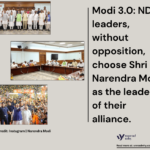A lot can be termed “whitewashed” as far as Indian history is concerned. Starting from the Mughal invasion to the 200-year British rule, India as a nation has faced tremendous hardships, where people all across the subcontinent were persecuted, killed, tortured, converted and whatnot. The problem is that the history textbooks that we have read so far show little about the crimes and atrocities of these perpetrators. Yet it has glorified them as people who contributed to the development of Bharat, its national identity, and its position in the international landscape today.
There is a lot to discuss and a lot to claim if one intends to signify how Indian history has been whitewashed and how events so important to us have either been downplayed or never shown. In this article, the whitewashing of the Mughal history will be discussed to effectively show how atrocities and crimes committed by Mughal invaders were kept hidden, and a more significant emphasis was put on depicting how they contributed to the development of the Indian society and also their cultural and architectural contributions to India.
Romanticizing of Mughal rule as a “Golden Era”
The Mughals, despite what they contributed or did not contribute, were romanticized as individuals responsible for the restructuring of the Indian civilization, which prospered for thousands and thousands of years before the Mughal invasion took place. Through this discourse, the Mughal Empire was symbolized as the epitome of art, culture, and architecture in India. On the contrary, I will argue that the Mughal invasion was primarily responsible for destroying our indigenous cultural heritage, our architectural marvels and our entire belief system over religion and spirituality.
Yes, they have built the Taj Mahal and the Red Fort, but what about the fact that these rulers of history, over hundreds of years, have destroyed more than 50,000 temples and monumental structures with cultural and historical significance to us? What about the devotees who were killed, butchered and tortured when they tried to protect the home of deities, which they worshipped and were part of both emotionally, mentally and spiritually? What about their freedom? Why did no one outline these atrocities and teach us over time how the Mughals, the so-called pioneers of Indian history, were murderers and rapists who tried to impose their logic and sense of religion over us?
Well, the answers to these questions are very controversial, as one who is a true scholar of Indian history will eventually find what their ancestors have gone through and what sacrifices they have made to protect our faith and to serve the Hindu ideology. Time and time again, Mughal rulers and their descendants of history have attacked Hindu temples with a particular intent: to disembody our faith system and show that their power transcends that of our deities and existing beliefs.
Well, it is good to see how, after such atrocities, forced conversions and mass destruction of Hindu places of worship, our faith system stands unshaken and dismayed. People have collectively held the notion of Bharat, an amalgamation of different religions, thoughts and ideologies.
Evidence implicating the destruction of Temples under the invasive rule of Aurangzeb
Now let’s talk specifics about what temples were destroyed and how religious grounds were turned into mosques, which unfortunately stands in our face to date.
Kashi Vishwanath Temple in Varanasi
The evidence showing the destruction of temples under Aurangzeb’s rule can be found in Maasir-i-Alamgiri, an account of the ruler’s experiences and overall rule in Bharat. The Emperor first wrote the book’s initial parts, and Sāqi Must’ad Khan wrote the later segments after his death. An Indian historian named Jadunath Sarkar was the first to translate these texts written in Persian into English, mainly during the British era, where he implicated the ideology and mindset of the ruler to treat people of other beliefs and faiths as “misbelievers”. According to the book “Maasir-i-Alamgiri: A History of the Emperor Aurangzeb-Alamgir (reign 1651 to1707 AD)” and I quote:
“The lord cherisher of faith learnt that in the provinces of Tetta, Multan and specially in Benaras the brahmin misbelievers used to teach their false book in their established schools and that admirers and students of both Hindu and Muslim used to come from great distances to these misguided men to acquire this vile learning,”
The book also said:
“His majesty eager to establish Islam orders to the governor of all the provinces to demolish the schools and temples of the infidels and with the utmost urgency to put down the teachings and public practice of the religion of these misbelievers,”
Subsequently, on September 2, 1669, following the orders of the Emperor, the Kashi Vishwanath Temple was destroyed. Similar evidence can also be found in a book written by Vikram Sampath, where in his book, he elaborately discusses the atrocities and crimes which were committed against the devotees in Kashi when the demolition took place. In the place of demolition stands the Gyanvapi Masjid, built by destroying a part of the Kashi Vishwanath Temple. In the book “Waiting for Shiva”, the author shows the long wait of “Nandi”, considered the Vahana of the Hindu deity Shiva.
Other temples destroyed as per the records of Maasir-i-Alamgiri –
Apart from Kashi Vishwanath, the Emperor also ordered the demolition of several other Hindu temples. The most significant examples include the destruction of Cooch Behar temples, Udaipur Maharana’s Temples, Mewar Someshwar Temple, Hatkeshwar Temple, Bijapur Temple, Pandarpur Temple and so on. The records, as mentioned in the book by Jadunath Sarkar, mention Hindus and followers of the Hindu faith as “Infidels” where they were seen following “false books”, and hence the destruction was justified. Like Really?
The problem is not what the Emperor did. The problem is why Indian history fails to put out these facts and teach young minds about the atrocities that their ancestors had faced for centuries. Why are people like Aurangzeb and Akbar shown as people of great virtue? And what true contributions did he and his followers make to Indian history by introducing new forms of music, dance, and architecture? Why there are almost no details about the contributions of the Marathas and Sikhs responsible for ruling out Mughal rule from India, which in the end became in tolerable?
Now, one will say that the details are too horrific for a viewer to look into, and hence, one must refrain from indulging in literature which signifies such atrocities. But my position is very different. It is my claim people all across the nation must look into these details and events to understand how certain people were glorified and their crimes whitewashed in history. We must ensure that we as a nation never indulge in anything of this sort. I claim that someone who has been glorified will inspire a thousand more to understand his viewpoint and justify that what he did was for a greater purpose.
Imposition of Islam as the only faith in Bharat under the direction of Mughal rulers, mostly Aurangzeb
Emperor Aurangzeb is often considered orthodox due to his stance or attempt to aggressively carry forward the task of imposing the Islamic faith mainly on the Hindu consciousness. He is considered “aggressive” as he ensured the implementation of Islamic principles more abruptly than any Mughal ruler, Akbar, Shah Jahan, etc. The problem with this attempt is that it affected the vast majority of Hindus who were a part of this land and the Hindu faith system which existed for centuries, even before Islam originated. Hence, the Islamic principles attacked the Hindu sense of morality as it sought the mass conversion of people of other religious backgrounds into its own.
The Indian subcontinent, instead of the undivided India, was a region where people of different faith and religious beliefs lived together, where people other than Hindus have tried accommodating the people who already existed. The Mughals were serious about India being the “fortress” of Islam. Hence, there have been numerous attempts by emperors of that dynasty in history to convert people of other faiths to the Islamic faith system. Here are a few facts of Indian history which justify the claim that I am about to make –
1. Re-imposition of the Jizya Tax on the non-Muslim majority
Aurangzeb is criticized for many things, but the most controversies he has faced is against his reapplying the Jizya Tax, which was abolished by his great-grandfather Akbar. The non-Muslims paid the tax, which allowed them to practice other faith, mainly in states run or governed by Islamic law. The tax also offered them protection against crimes which the Emperor himself committed. However, on a positive note, the amount of tax was set based on the payer’s ability, where someone rich would pay more, and someone poor or financially inefficient would pay less. The tax system, in its entirety, implicated Hindus as second-class citizens who were forced to live by the principles of Islamic laws.
2. Strict implementation of the Islamic “Sharia” Law
The Mughal rulers, mainly Aurangzeb, did their best to implement the Sharia law more than anyone considered the list of his predecessors. Under his supervision, a group of scholars named Muhtasibs were developed, whose primary goal was to exercise executive and judicial powers to prevent and punish anyone not abiding by the Sharia laws’ morality and public behavior expectations. For example, if anyone violated the orders of the Sharia law, which included prohibitions against the consumption of alcohol or opium, they were severely punished and sometimes sentenced to death.
The key Hindu festivals such as Holi and Diwali were also banned, possibly due to the fear that it might influence public unification against the ill consequences of the Sharia law. Little did he know that the imposition of a law that terminated the celebration of festivals of this magnitude was unfeasible as certain parts of Bharat would still follow certain rituals and practices to protect their faith and beliefs.
3. Religious persecution and killing of Sikhs
The intolerance of Aurangzeb as far as religion is concerned did not limit itself to Hindus; instead, it extended to other faith systems such as Sikhism. One such instance which can be recalled is the persecution and beheading of the ninth Sikh Guru named, Guru Tegh Bahadur, who was executed in the year 1675, as he refused to convert to the Islamic faith. The later incidents are pretty well documented now, where they led to the outrage of the Sikh community against the Mughals, which led to bloody conflict between these two communities.
Now tell me, how many of you were aware of this information? Not me, as I learned nothing of this sort in the school textbooks and even in books published in the higher secondary domain. This effectively shows how Indian history was selectively discoursed, where facts which implicate hate against the majority in the past were omitted. People committing acts of hate and crimes were repeatedly glorified.
Why is it important to know the horrific, whitewashed past of Indian history?
We must heal from the wounds which were left untreated. It is essential to confront the truth and destroy the false dilemma that everything was smooth and refined. Problems relating to religion, caste and whatnot are supposedly increasing now in India. Well, it is not. It is history which provides a better opportunity for reconciliation, not unawareness. It is Indian history that can form true alliances as it helps identify the root causes of certain ideological differences between the people of Bharat today. It is indispensable to understand the mistakes of our ancestors so that we do not engage in and entertain situations that encourage such mistakes to happen again shortly.
It seems that many authors of the 21st century have come forward to state these facts with evidence and actual citations, which makes it hard for people with opposing ideologies to contradict. Authors like Vikram Sampath, J. Sai Deepak, and Anand Ranganathan have shown the courage to explicitly show how Indian history, which claims to be a tale of smooth transactions, was not smooth. They have shown how people nationwide had no idea of these facts, which is entirely not their fault. The current discourse is to be blamed as it allows little space for content like these to appear and pages for the perpetrators of crimes glorified as true reformers and change-bringers. Sorry!
As a scholar, I will not accept it. It is not me; I am pretty sure people all across the nation have started demanding the truth, which is a good thing, as this can only inspire more people to come up with their version of the truth with actual evidence. People across the board must engage in discussions, as this is a time when unity matters the most. How can unity develop when past differences are not addressed, and history is not shown as it is and as brutal as it may appear?
Verdict
As a scholar and learner, my independent claim is that our history textbooks must be changed. It requires the inclusion of essential characters such as Shivaji and people from significant community groups such as Ashoka, Chola, Vijay Nagara, Pallavas and so on, who did their best to rule out fear psychosis and provide this nation with the scope to think as Independently as possible. It requires adding relevant information and facts about Subhas Chandra Bose, who did away with the atrocious rule of the British Empire in India.
As important as it is to know the contributions of glorified freedom fighters in the war against the British brute force, it is equally important to understand the motives and lives of our forgotten heroes who had so much to contribute to the development of the independent India in which we live and prosper.
FAQ
1. Why is it important to uncover the whitewashed parts of Indian history?
Understanding the past: It helps us understand the true nature of historical events, the motivations of historical figures, and the impact of these events on the present day.
Avoiding repetition: By knowing the mistakes of the past, we can work towards preventing them from happening again.
Promoting justice: Uncovering the truth can help address historical injustices and promote social and political equality.
2. Who is responsible for whitewashing Indian history?
Colonial rulers: British colonial authorities often presented a distorted view of Indian history to justify their rule and suppress dissent.
Nationalist historians: Some nationalist historians, particularly during the colonial period, may have exaggerated the positive contributions of certain rulers or groups to promote a sense of national unity.
Educational systems: The curriculum and textbooks used in Indian schools have often been influenced by these perspectives, leading to a biased understanding of history.
3. What are some specific examples of the whitewashing of Mughal history?
Emphasis on cultural contributions: Mughal rulers are often portrayed primarily as patrons of art, culture, and architecture, while their military conquests and religious intolerance are downplayed.
Justification of forced conversions: The practice of forced conversions by Mughal rulers is often justified as a necessary means of promoting religious unity or as a result of cultural exchange.
Minimization of atrocities: The violence and destruction caused by Mughal invasions and conquests are often minimized or excused.
4. How did the Mughals contribute to the destruction of Hindu temples?
How did the Mughals contribute to the destruction of Hindu temples?
Religious intolerance: Mughal rulers, particularly Aurangzeb, were known for their intolerance of other religions and often ordered the destruction of Hindu temples.
Taxation policies: The imposition of taxes on non-Muslims, such as the jizya, was seen as a form of religious discrimination and often led to the destruction of temples.
Political motivations: In some cases, the destruction of temples was motivated by political or military considerations, such as consolidating power or suppressing dissent.
5. What are the implications of whitewashing Mughal history?
to misunderstandings about the causes and consequences of historical events.
Reinforcement of stereotypes: It can reinforce negative stereotypes about different religious groups and contribute to social tensions.
Hindrance of reconciliation: By obscuring the painful truths of the past, it can hinder efforts to achieve reconciliation and social harmony.

















